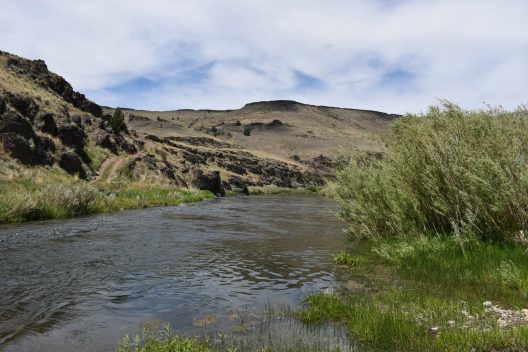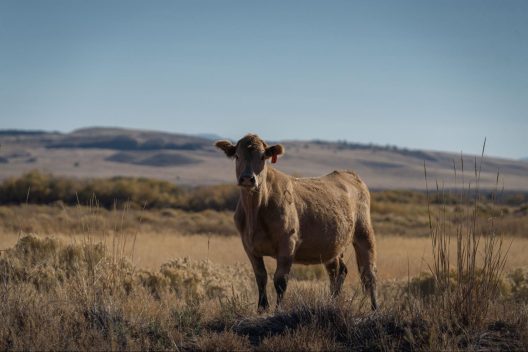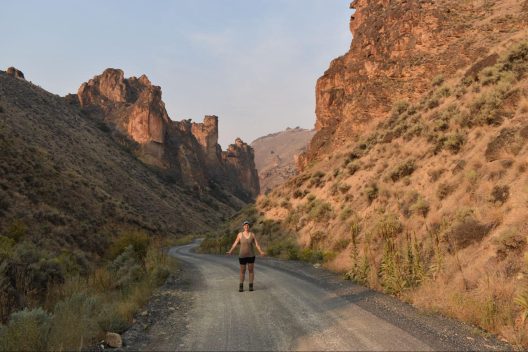Money Doesn’t Grow on Public Lands: The Cost of Livestock Grazing in the American West
Author’s note: the following reflects my personal views, not necessarily the views of Friends of the Owyhee, a grassroots non-profit organization that aims to conserve the Owyhee bioregion in an inclusive, non-partisan way.
For most of my adult life I’ve wanted to work in conservation. Protecting and healing our natural world is an exciting cause that is particularly crucial with the effects of climate change hot on our heels. Although I’m a marine biologist by training, I was happy to find work in conservation where I could get it. When I found myself applying for a job in public land conservation in my eastern Oregon hometown, I reasoned that it was still within the realm of conservation. I was hoping to work with the ocean, but I should know that you can’t be too picky in rural (not to mention landlocked) eastern Oregon.
I started working for Friends of the Owyhee in 2021, and since then, I’ve become a fairly avid public lands conservation advocate. Whenever public lands are mentioned in class here at SMEA, several of my colleagues turn to look at me, trying to gauge my reaction. I usually feel my face heat up, but I also feel pride bloom in my chest. Safeguarding our public lands, which we as Americans are so blessed to have, is a cause worth fighting for.
Anyone following global conservation efforts has likely heard of the 30×30 campaign, which asserts that in order to promote resilience to climate change, we have to protect at least 30% of the planet’s oceans and land—including rivers, wetlands, and more—by 2030. What “protect” entails varies around the world with sociopolitical and cultural values, but it typically means little to no human contact by way of exploitative industry or development. The Nature Conservancy describes protected areas as land or sea that must “be conserved through an effectively and equitably managed, ecologically representative, well-connected system of sustainably managed protected areas where they are most needed.” Protected areas should be thoughtfully managed, but it’s up to each participating country to interpret that into specific plans and policies.
Shortly after taking office, President Biden released a report titled Conserving and Restoring America the Beautiful that outlines how the United States’ goal of protecting 30% of its lands and waters by 2030 will support communities throughout the country while protecting wildlife habitat and biodiversity. Although the Natural Resources Defense Council (NRDC) deems this a popular move among American voters, putting these goals into practice is extremely challenging.
A commonly cited “low-hanging fruit” for this campaign is our nation’s public lands. Public lands, or lands that have been designated to belong to all Americans, account for 615 million acres or 27% of land in the United States. Most of our nation’s public lands are in the West, particularly in Alaska, Nevada, and California (these states contain 36.2%, 9.1%, and 7.4% of the nation’s public lands, respectively). Some of these lands eventually get designated into various categories of protection including national parks, national monuments, national wildlife refuges, and many others. The management of these lands transfers from the hands of the Bureau of Land Management (BLM) or the United States Forest Service to other federal agencies and state departments. For example, a parcel of undesignated federal land may be declared a national wildlife refuge, whose management would then be transferred from the BLM to the U.S. Fish & Wildlife Service. This parcel would then be managed according to the standards of national wildlife refuges. Each land designation—of which there are numerous—is accompanied by its own set of regulations, protocols, and goals for management.
But much of our public land remains, well, public. And if we just protected it all, we’d get pretty close to that goal of 30% land protected! Right?

Unfortunately, it’s not that easy. Public lands managed by the BLM are multi-use as per the Federal Land Policy and Management Act of 1976 (FLPMA, pronounced “FLIP-muh”). Multi-use means that public land is often used for a variety of purposes, including energy development, mining, livestock grazing, and timber harvesting. Suddenly closing off these lands to such exploitative uses wouldn’t be a simple process; there are numerous vested interests that would fight back. That’s why I tend to disagree with the idea of public lands being “low-hanging fruit” for the 30×30 campaign, as much as I wish they were.
I realize that not everyone can prioritize radical conservation initiatives. At the end of the day, people, including ranchers, need to feed their families and keep a roof over their heads. I believe that protecting our public lands from exploitation is in our best interest collectively, but I also recognize this is a complex situation with a wide variety of competing stakeholders. That said, thanks to my interdisciplinary education here at SMEA, I have the tools to evaluate such a complex problem through an economic lens. Given what I know about economic theory, I started to wonder how livestock grazing compares to protecting public lands when considering the net economic benefit to society as a whole, which includes net benefits to consumers, producers, and society at large.
Early on in my short tenure working in public lands conservation, I quickly came to understand livestock grazing as a prominent threat to keeping public lands wild and intact. Livestock grazing is permitted under FLPMA, despite how destructive it is to these natural and often fragile arid ecosystems. But let’s set aside the ecology and focus on the economics of this issue.
Livestock grazing takes place on 155 million acres of public land—about 25% of the nation’s public land. The BLM administers nearly 18,000 permits and leases to ranchers, who must pay a fee based on how much forage an animal requires for one month, an indicator termed “animal unit month” (AUM). This fee is calculated on a yearly basis by the BLM according to a formula set by the Public Rangelands Improvement Act of 1978. To give you a sense of the range, the 2018 grazing fee was $1.41 per AUM, yet the 2019 fee fell to the baseline $1.35 per AUM. Comparatively, in 2019, the grazing fee on private land in the western U.S. was $22.60 per AUM. That’s nearly 1600% more than the BLM’s price. The BLM cites that, in 2015, the livestock grazing program cost $36.2 million to administer, but it brought in just $14.5 million in grazing fees. This discrepancy in numbers caught my attention; it was clear that the livestock grazing program is subsidized by the federal government. If the BLM were to charge the same amount per AUM on public land as the average for private land, the magnitude of this discrepancy would likely be reduced considerably.
What’s more, what constitutes “an animal” within the AUM is a bit of a gray area and may result in ranchers taking advantage of this program. The BLM states that it translates to “one cow and her calf, one horse, or five sheep or goats.” But with nearly 18,000 permits and leases, over 21,000 allotments, and incredibly high levels of vacancy throughout the agency, regulation enforcement is likely to be barely existent, let alone thorough. This loophole of sorts not only incentivizes grazing more livestock than covered by a permit, but also lacks the risk of repercussions.
As a public lands conservation advocate in the rural western U.S., I’ve had my fair share of challenging encounters. My defining interaction with a rancher consisted of a total stranger launching into a chastizing diatribe about how environmental and conservation efforts aim to “lock up the land,” which would negatively impact the ranchers all across the West that are “feeding America.” This interaction highlighted to me how many ranchers that graze their cattle on public lands value their work and see it as threatened by conservation efforts. The BLM is losing money hand over fist with this program, but if these cattle really are feeding people around the nation, maybe it is economically beneficial and is worthy of subsidization after all. So are ranchers in the western U.S. really feeding America?
The answer, it turns out, is no.

Not in a meaningful sense, anyway. Some sources claim that less than 2% of our nation’s beef comes from cattle grazed in the American West on public lands; the rest is comprised of imported beef (about 11% according to USDA data for 2020) and cows raised on private rangeland, according to some sources, although an exact percentage is not cited. That small percentage of our nation’s beef is nearly negligible in that you wouldn’t notice a difference in price or availability at the grocery store. In this sense, beef cows grazed on public lands in the West do not generate consumer surplus, or net benefits to consumers.
But it’s not just the dollars and cents on USDA reports that are at stake here. Economists assign dollar amounts to all costs and benefits—including societal benefits for identity values—in order to compare across boundaries like between sectors. Many proponents of public land livestock grazing assert that it is a cornerstone cultural practice, the societal values of which should appear in a cost-benefit analysis. But there is also monetary value in the climate change mitigation potential that public lands have, which is key considering the position we’re in at the moment. These are just some of the components that should be considered in a thorough cost-benefit analysis of this issue.
The Intergovernmental Panel on Climate Change (IPCC) has repeatedly cautioned the global populace about how little time we have to avoid the worst effects of climate change. One of the major contributors to our atmosphere’s warming is methane, a greenhouse gas that has 80 times the warming power of carbon dioxide (CO2). At the moment, activities taking place on public lands are part of the problem by way of fossil fuel extraction and livestock grazing, since cows are the top agricultural source of global greenhouse gasses.
Reports claim that cattle produce just 4% of all greenhouse gas emitted in the U.S. While that’s a relatively modest amount, it does not consider that the presence of livestock on public lands also disrupts the carbon sequestration process of biomass and soils, a component of rangeland ecosystem services. Studies that estimate the economic value of these services are few, but a 2022 study estimated that 95.6 million acres of public land protected as national wildlife refuges provides a rate of carbon sequestration that is worth $976 million annually in societal benefits. We need a considerable amount of additional data to make any definitive conclusions about what the carbon sequestration rate would be across the 155 million acres of land that is used for livestock grazing. That said, such evidence is certainly encouraging with respect to the economic potential of these lands.

There is no doubt that this is a fraught topic. There is a substantial amount of ecological, sociocultural, and economic research left to do and other considerations to keep in mind before simply prohibiting all livestock grazing on public lands. This debate is far from solved, but it is worth conducting a thorough cost-benefit analysis of this issue so as to assess and compare the economic benefits of both protecting public lands and the current multi-use management regime. I also want to highlight that the primary issue is not small family operations, but rather large corporations that appear to be capitalizing on a federal program. As I mentioned, I believe that there is societal value in small American ranches owned and operated by individuals. While economics is important to consider, society also values equity and ownership.
My time working in public land protection has shown me numerous benefits of keeping these lands of the American West wild and intact. It’s also shown me that there are deep cultural divides and political underpinnings that cannot be addressed solely through an economic lens. We have a lot of work to do to find the best path forward, but public lands certainly have incredible potential to help mitigate climate change and be a meaningful addition to the U.S.’s 30×30 goals.